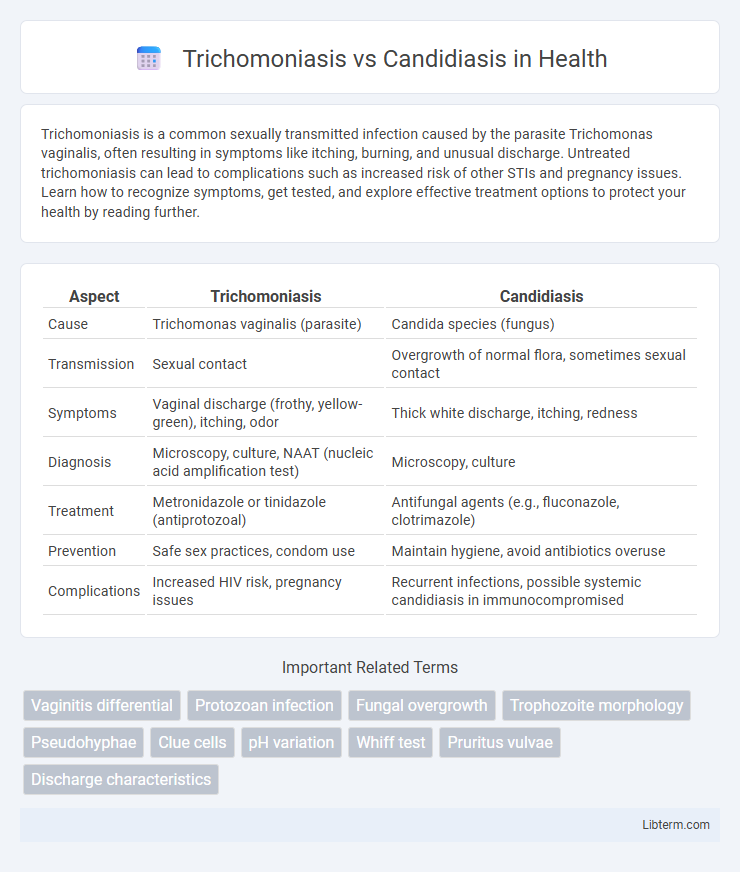Trichomoniasis is a common sexually transmitted infection caused by the parasite Trichomonas vaginalis, often resulting in symptoms like itching, burning, and unusual discharge. Untreated trichomoniasis can lead to complications such as increased risk of other STIs and pregnancy issues. Learn how to recognize symptoms, get tested, and explore effective treatment options to protect your health by reading further.
Table of Comparison
| Aspect | Trichomoniasis | Candidiasis |
|---|---|---|
| Cause | Trichomonas vaginalis (parasite) | Candida species (fungus) |
| Transmission | Sexual contact | Overgrowth of normal flora, sometimes sexual contact |
| Symptoms | Vaginal discharge (frothy, yellow-green), itching, odor | Thick white discharge, itching, redness |
| Diagnosis | Microscopy, culture, NAAT (nucleic acid amplification test) | Microscopy, culture |
| Treatment | Metronidazole or tinidazole (antiprotozoal) | Antifungal agents (e.g., fluconazole, clotrimazole) |
| Prevention | Safe sex practices, condom use | Maintain hygiene, avoid antibiotics overuse |
| Complications | Increased HIV risk, pregnancy issues | Recurrent infections, possible systemic candidiasis in immunocompromised |
Overview of Trichomoniasis and Candidiasis
Trichomoniasis is a common sexually transmitted infection caused by the protozoan parasite Trichomonas vaginalis, characterized by symptoms such as itching, burning, and discharge primarily in the urogenital tract. Candidiasis, often referred to as a yeast infection, is caused by the overgrowth of Candida species, especially Candida albicans, affecting mucous membranes including the vagina and mouth. Both infections present distinct pathophysiology and treatment protocols despite overlapping symptoms like inflammation and discharge.
Causes and Transmission
Trichomoniasis is caused by the protozoan parasite Trichomonas vaginalis, primarily transmitted through sexual contact, making it one of the most common non-viral sexually transmitted infections. Candidiasis results from the overgrowth of Candida species, especially Candida albicans, which are normally present in the body but proliferate due to factors like antibiotic use, immunosuppression, or hormonal changes; transmission can occur through direct mucosal contact or opportunistic infection. Understanding these distinct etiologies and modes of transmission is essential for accurate diagnosis and targeted treatment.
Common Symptoms Comparison
Trichomoniasis and Candidiasis both cause vaginal discomfort but differ in symptom presentation. Trichomoniasis typically presents with frothy, yellow-green vaginal discharge and itching, while Candidiasis is characterized by thick, white, cottage cheese-like discharge accompanied by intense itching and redness. Both infections may cause vaginal irritation and discomfort during urination or intercourse, requiring accurate diagnosis for effective treatment.
Risk Factors and Susceptibility
Trichomoniasis risk factors include multiple sexual partners, unprotected intercourse, and a history of other sexually transmitted infections, increasing susceptibility particularly in sexually active individuals. Candidiasis susceptibility is heightened by antibiotic use, diabetes, hormonal changes such as pregnancy, and immunosuppression, which disrupt normal vaginal flora and promote yeast overgrowth. Both infections disproportionately affect women, with underlying health conditions and sexual behavior playing crucial roles in their prevalence.
Diagnosis and Testing Methods
Diagnosis of Trichomoniasis primarily involves microscopic examination of wet mounts, rapid antigen tests, or nucleic acid amplification tests (NAATs) that offer high sensitivity and specificity for detecting Trichomonas vaginalis. Candidiasis diagnosis relies on clinical evaluation combined with microscopic identification of Candida species in vaginal swabs using potassium hydroxide (KOH) preparation and fungal cultures to confirm overgrowth. Molecular testing methods and PCR assays enhance the accuracy of differentiating Trichomoniasis from Candidiasis, guiding targeted treatment approaches.
Key Differences in Clinical Presentation
Trichomoniasis typically presents with a frothy, yellow-green vaginal discharge and intense vaginal itching or irritation, often accompanied by a fishy odor, while candidiasis usually causes thick, white, cottage cheese-like discharge with severe itching and redness but no strong odor. Trichomoniasis symptoms often include dysuria and dyspareunia, whereas candidiasis may lead to soreness and swelling of the vulva and vaginal walls. Fever and systemic symptoms are rare in both infections, but trichomoniasis more frequently causes asymptomatic infections compared to candidiasis.
Treatment Options and Medications
Trichomoniasis treatment primarily involves the use of metronidazole or tinidazole, which are nitroimidazole antibiotics effective in eradicating the Trichomonas vaginalis parasite. Candidiasis requires antifungal medications such as fluconazole or topical azoles like clotrimazole and miconazole, targeting Candida species responsible for the infection. Both conditions necessitate timely intervention to avoid complications, with trichomoniasis demanding partner treatment to prevent reinfection.
Potential Complications
Trichomoniasis can lead to complications such as increased risk of HIV transmission, pelvic inflammatory disease (PID), and adverse pregnancy outcomes including preterm delivery and low birth weight. Candidiasis, while often less severe, may result in chronic mucosal infections, systemic candidemia in immunocompromised individuals, and secondary infections causing tissue damage. Both infections require prompt diagnosis and treatment to minimize these potential complications and prevent long-term health issues.
Prevention and Healthy Practices
Effective prevention of trichomoniasis includes consistent use of barrier protection methods such as condoms, regular screening for sexually transmitted infections, and limiting the number of sexual partners. Maintaining optimal vaginal health through proper hygiene, avoiding douching, and wearing breathable cotton underwear reduces the risk of candidiasis by preventing yeast overgrowth. Both infections benefit from prompt medical diagnosis and treatment to avoid complications and transmission.
When to Seek Medical Advice
Seek medical advice promptly if you experience persistent vaginal itching, abnormal discharge, or discomfort during urination, as these symptoms can indicate Trichomoniasis or Candidiasis. Trichomoniasis often presents with frothy, yellow-green discharge and a strong odor, while Candidiasis typically involves thick, white, cottage cheese-like discharge. Early diagnosis and treatment by a healthcare provider are crucial to prevent complications and transmission of these common sexually transmitted infections.
Trichomoniasis Infographic

 libterm.com
libterm.com